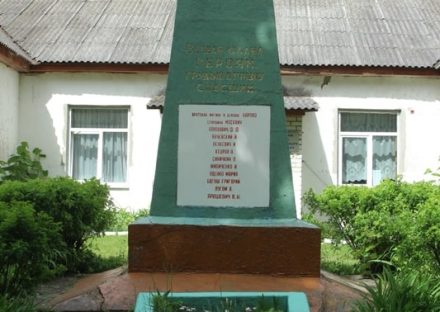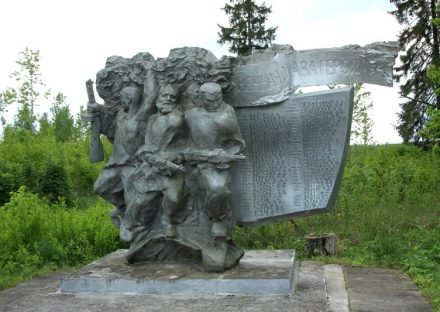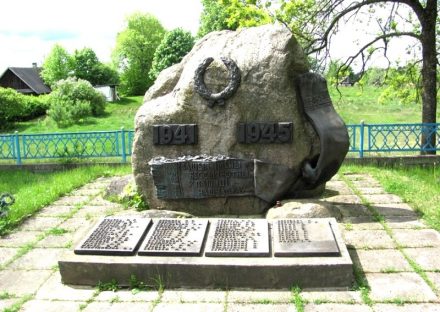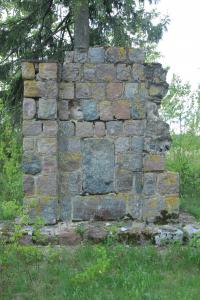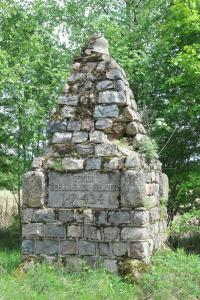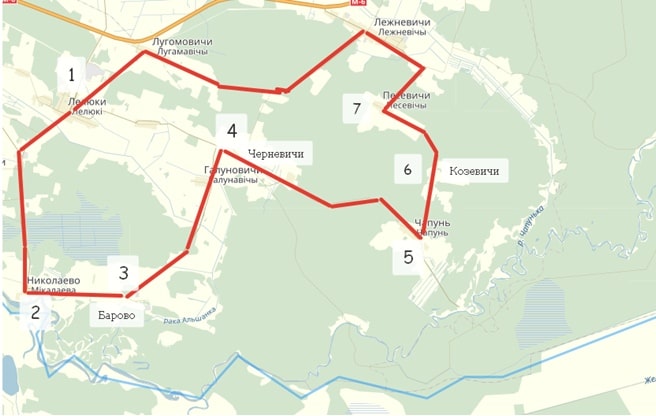
“The Roads of Two Wars”
Route: Lelyuki – Nikolaevo – Barovo – Chernevichi – Bol. Chapun; – Kozevichi – Pesevichi.
Route length: 39.8 km
Route time: 5-6 hours
Type: bicycle
Type: military history
Organizer: State Educational Institution “UPK Lelyukinsky kindergarten-secondary school”, sports and tourism sector of the Ivye regional executive committee
Contacts: 801595 69077
Description of the main attractions along the route:
Lelyuki
Monument to the soldiers-compatriots who died during the Great Patriotic War in the agro-town of Lelyuki
The obelisk was installed in 1967. Every year, rallies are held near the monument, timed to the holidays of May 9 and July 3.
Nikolaevo
Monument to the soldiers-fellow countrymen who died during the Great Patriotic War in the village of Nikolaevo
The monument is located in the village of Nikolaevo on the territory of the Church of the Holy Intercession
The obelisk was installed in 1967. The surnames and names of the killed partisans who took part in the battle to defeat the German garrison in the village of Lugomovichi are indicated on the monument.
In 1969, in the village of Nikolaevo, one of the episodes of the film “Sons Go to Battle” was filmed, which was filmed by the film studio “Belarusfilm”. The main director of the film was Viktor Turov, and the text of several songs for the film was written by Vladimir Vysotsky, who, together with his wife, Marina Vlady, came to Nikolaevo during the filming of the film.
Barovo
Monument at the mass grave of Soviet soldiers and partisans in the village of Barovo
The memorial sign was installed in 1964. Soldiers-partisans who died during the Great Patriotic War on the territory of the Ivye region are buried in the mass grave.
Chernevichi
Place of extermination of civilians in the village of Chernevichi
The massacre of civilians in the village of Chernevichi took place on June 17, 1944. The Germans and policemen surrounded the village. Most of the inhabitants managed to escape into the forest and hide. Only two families remained in the village – Kisly and Semenyashi.
Near the place where innocent people died, the villagers erected a high cross and a monument. In memory of the victims and so that there is no more war in the world.
Bolshaya Chapun
Monument at the mass grave of Soviet soldiers and partisans in the village of Bolshaya Chapun
The partisans with all military honors buried those who died during the defeat of the garrison in Lugomovichi at the local cemetery in the village of Bolshaya Chapun. In 1964, a memorial obelisk was erected at the burial site.
Monument to German soldiers who died during the First World War in the village of Bolshaya Chapun
The burials of German soldiers in the village of Bolshaya Chapun are located on the territory of the local cemetery and is a site 50 m long and 20 m wide, conventionally divided into two parts. The graves are mound-shaped earthen mounds. The total number of visible mounds is about 50. There is no information about the names and surnames, as well as the dates of burial.
In the center, along the edge of the burial, there is a stone monument in the form of a rectangle, approximately 2.5 meters high. In the center of the monument there is a plaque with an inscription in German “SEINER GEFALLENEN HELDEN J R 433”, which means “To our fallen heroes”, capital letters “J R” stand for “Infanterie regiment” – an infantry regiment, and number 433 is a regiment number. The entire inscription on the tablet should read as follows: “To my fallen heroes. 433rd Infantry Regiment “.
Kozevichi
Individual grave of the partisan A. Yu. Vertinsky at the cemetery in the village. Kozevichi
Vertinsky Anton Yurievich, was born in the village of Krasny Bereg, Minsk region. He fought as part of the Sibiryak partisan detachment. On May 10, 1944, while on a combat mission, he was captured by the Germans near the village of Kozevichi and brutally tortured by the Nazis. He was buried in the cemetery in the village of Kozevichi.
In 1967, a monument was erected on the grave.
Monument to German soldiers who died during the First World War in the village of Kozevichi
One of the large burials of German soldiers on the territory of the Ivye region is located in the village of Kozevichi in the Lelyukinsky village council. The burial was carried out on the territory of the local cemetery and is a site 50 m long and 10 m wide. The graves with rectangular concrete gravestones measuring 2.0 mx 1.0 m are arranged in 4 rows. The total number of graves is about 40. There is no information about the names and surnames, as well as the dates of burial.
In the center, along the edge of the burial, there is a stone monument in the form of a pyramid, 3 meters high. Below, in the center of the monument, there is a plaque with an inscription, which is similar to the one that survived in the village of Bolshaya Chapun, with the only difference that not the 433rd, but the 434th infantry regiment is indicated. According to local residents, a large oak cross was leaning against the back of the monument. Given this evidence, we can conclude that the monument itself was erected at a later period, and initially this was the cross instead.
Pesevichi
Individual grave of the partisan S.D. Zharikov at the cemetery in the village of Pesevichi
Zharikov Semyon Dmitrievich, was born in 1918 in the village of Golovenchili, Mogilev region. He had the military rank of senior sergeant, was the commander of a section of the partisan detachment “Belarusian Avenger”. Died March 16, 1944. He was buried in the cemetery in the village of Pesevichi.
In 1967, a monument was erected on the grave.

